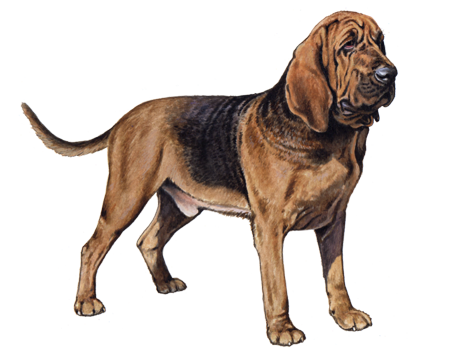
Finnish Hound
The Finnish Hound is found predominantly in Finland and is used almost exclusively for hunting hare or fox. The breed is usually calm and friendly, which means they make for a good family pet. Keep in mind that this breed tends to bond closely with their owners, and they don’t do well when left alone for long periods. Because of their stubborn streak, they also aren’t necessarily the best option for novice dog owners.
Interested in discovering if your dog is a Finnish Hound?
Check out Wisdom Panel's DNA tests.

Finnish Hound Traits
General Appearance
These medium-sized dogs have a similar appearance to a Beagle, with the same short, smooth coat and signature tri-coloring. The Finnish Hound, however, has a body that is longer than its height, with a clear chest and rib cage that reaches to the elbows.
Coat and Colouring
The Finnish Hound has an undercoat that is short, dense, and soft, while their medium-length outer coat is straight, dense and harsh. They are tri-colored in black, white, and tan, with a black mantle and tan on the head, lower parts of the body, shoulders, upper thighs, and legs. Other parts of the coat are white.
Distinctive Physical Traits
The Finnish Hound has features similar to Beagle, but they have a longer body. This breed is strong, but they are not heavy or overly commanding.
Finnish Hound Temperament
As an active hunting dog, the Finnish Hound requires plenty of exercise to avoid boredom. When properly cared for, they make intelligent, high-spirited, and friendly companions. They are also good family pets since they get along well with other animals and children.
Finnish Hounds are easy to train; it’s important to do so early and steadily since their hunting instincts can kick in on a whim.
Finnish Hound History
The Finnish Hound dates back with the beginning of the Suomen Kennelklubi—a precursor to the Finnish Kennel Club—in 1889.
At the time, a group of breeders set out to find individual dogs with the best hunting traits and those most suited to the Finnish landscape from within the Finnish dog population. They started with a selection of three dogs for the first Suomen Kennelklubi show and advanced to eight the following year. By 1893, the group began to determine some of the breed standards, including color and temperament.
Today these dogs are still found mostly in Finland, where the annual Kilpa championship is an important event for working Finnish Hounds.
Finnish Hound Care
Nutrition
Feed your Finnish Hound a high-quality dog food suited to their particular age and activity level, as well as any additional health concerns.
As with any dog, it’s important to monitor the amount of food and treats that you give your Finnish Hound to avoid having them gain weight, especially as they age. Your veterinarian is always a good source to help provide you with appropriate nutrition and feeding guidelines.
Grooming
The Finnish Hound has a medium-length outer coat that is relatively easy to maintain. Once weekly brushings with a grooming mitt or brush should do the trick. This breed does shed moderately, but regular brushings will help reduce hair loss.
All dogs require regular dental care, including at-home teeth brushing and professional dental cleanings, and the Finnish Hound is no exception. Maintaining good dental hygiene is important for their overall long-term health.
Exercise
As with most high-energy Hound breeds, you should exercise your Finnish Hound every day. They’ll love activities that involve running or walking briskly, and they’ll excel at anything that uses their hunting instincts.
Training
Finnish Hounds can be difficult to train because of their independence and tendency to be stubborn. Early training combined with a lot of patience can go a long way, though.
Because wanderlust is strong with this breed, it’s important to properly train them to avoid them dashing off at a moment’s notice.
Finnish Hound Genetic Health Conditions
-
Factor VII Deficiency
Factor VII Deficiency is an inherited blood clotting disorder that results in excessive bleeding occurring after a severe trauma or surgery. The signs of the disease are typically mild but can vary in severity in different affected dogs.
-
Progressive Early-Onset Cerebellar Ataxia
Progressive early-onset cerebellar ataxia is a disorder of the nervous system that causes ataxia (uncoordinated movements) and loss of balance.
Knowing if your Finnish Hound is a carrier or at-risk for these conditions can help you and your veterinarian plan for your pup's lifelong care. With Wisdom Panel™ Premium, you can get results for over 200 genetic health tests.
Breed Group
Hound
The most common ancestral trait of this group is being used for hunting. Some use acute powers of scent to follow a trail while others demonstrate the gift of stamina as they run down a quarry. Beyond these two common traits, however, generalizations about hounds are hard to come by as the group is comprised of a very diverse lot of breeds.
Resources
https://www.skk.se/en/NKU-home/nordic-dog-breeds/finland/finnish-hound/
http://www.fci.be/Nomenclature/Education/051g06-PRE-en.pdf
https://dogell.com/en/dog-breed/finnish-hound
Reviewed 26 July 2020 by Cindy Elston, DVM, MPH












































